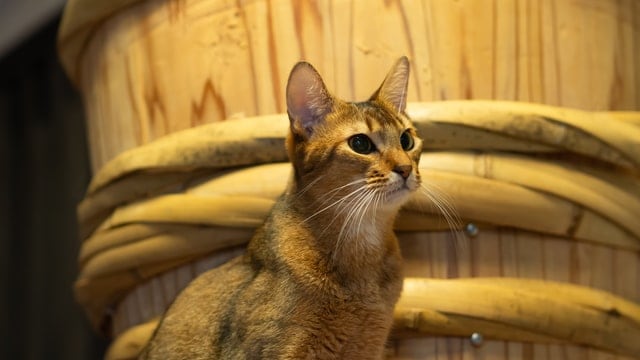
The Burmese cat is a unique feline of its kind: affectionate, exuberant and reckless, it is the ideal cat for those who wish to have a companion and cover him with caresses (as a plush), a faithful friend but sociable with the rest family and friends, and a companion to travel with; it likes to take a walk in the car or in the train and observe through the windows, fascinated, the landscapes he meets. It does not require a lot of care, but it is necessary that its owner shows them his affection by devoting a little of his time to the game and to the caresses.
The origins of the Burmese cat
The origins of the Burmese cat are very old: it’s portrait appears for the first time in a book of poems from Siam, in the Ayutthaya period (1350-1767), and a legend says that this cat lived alongside the Burmese monks, who considered it sacred.
If the Burmese has been talked about again, the credit goes to a psychiatrist in the United States Navy. In 1930, in fact, Doctor Joseph Thompson, while walking in the streets of Rangoon, the capital of Burma, met and fell under the spell of a beautiful cat of Tonkinese breed, with a soft expression and a strange dress. brown, which he called Wong Mau. When it came time to return to San Francisco, he could not part with her and brought her back with him. Taking her for a “failed” Siamese, and confident about the birth of “true Siamese”, he made her mate with a male of this breed.
The result was quite surprising: four kittens were born, two Siamese and two Tonkinese. With the help of a few geneticists, he discovered that the mother and father carried two different genes. He developed a breeding program by importing three other Tonkinese from Burma; he crossed them with Siamese endowed with pedigree and six years later, he succeeded in demonstrating the existence of a new feline breed: the Burmese, whose morphology is different both from that of the Siamese and that of the Tonkinese.
In 1936, the Burmese Club was founded and during that same year the CFA (Cat Fanciers’ Association) recognized the breed in the sable variety of brown coat. In Europe, the first specimens appeared in Great Britain in 1947, where other color varieties were created. These copies were not accepted in the championship until 1953.
The ideal cat
The Burmese cat is unique and cannot be compared to other cats, mostly because of the soft and kind expression on it’s face and eyes. The structure of their body makes them a strong and quite heavy cat. It has a broad and powerful thorax, a strong bone structure and a well-developed and toned musculature. These characteristics give it a high weight compared to its size, which is average.
The tail, thick at the base, tapers towards a round, straight end. The head is rounded and of medium size; the face has full cheeks that gently tap into a short, blunt triangle. The nose has a small stop at the base and the chin, seen in profile, should show a strong lower jaw. The ears, set wide apart, are tilted forward, of medium size, open at the base and rounded at the tip. The neck is short and well developed
The eyes are widely spaced, round and large; their color can vary from yellow to intense gold. The legs are of average length and frame, are proportionate to the body, and are carried by rounded, medium-sized feet. The coat is abundant, soft and well adherent to the body; the texture is fine and shiny.
Hair color
The original hair color of the Burmese cat is sable, where the coat is brown, warm brown or dark hazel; the inside of the legs, the neck and the belly are lighter; the nose and pads are brown or black. In addition, different color varieties that have been created are accepted.
• Sepia blue, where the base color is a light silvery gray which becomes even lighter on the sides, belly and neck, while the pads and nose are gray.
• Champagne sepia, with a very light chocolate color, almost beige, with darker mask and tail and light brown or pinkish nose and pads.
• Sepia platinium, where the coat color is very light silvery gray, mixed with beige or light sand; the belly and neck are lighter (beige), while the mask and tail are slightly darker; the nose and the pads are pink or lavender.
• Red sepia, where the base color is a warm red tending towards apricot which becomes lighter on the sides and belly; the nose and the pads are pink.
• Cream sepia, with a beige, red, very light cream color; the mask and tail are slightly darker and the nose and pads are pink.
• Tortie sepia, where the base color is a mixture of brown and red, with a black or pink nose and pads.
• The blue cream sepia, where the color of the dress is a mixture of blue and cream, with the nose and the pads in pink or blue.
In all varieties, the lower part of the body is lighter in color compared to the back. The dress should appear uniform, without shadows or stripes; their presence is only tolerated in kittens and young subjects, whose coat is moreover clearer.
The character
Today’s Burmese cat is different from its ancestors as it is less stubborn and brash, less “meows” and more emotionally stable. It puts all their trust in his human companion: it considers him to be the one who gives him the food and warmth it needs. This is why it lives in close contact with their master whom it sees only a little bigger, but not different from them. Sweet and a little shy, they are always in search of attention and praise. It leads a serene and balanced life which does not prevent them from being always active and exuberant.
They are friendly, playful and very curious: we absolutely cannot prevent them from inspecting every corner of the house because it has the innate ability to open doors and drawers! Thanks to it’s sociable character, it has no difficulty in sympathizing and playing with children and strangers, provided that the latter arouse his confidence; it indeed seems capable of guessing the emotions and the nature of the people they has in front of them.
In all situations, it shows great adaptability and intelligence. It is not pushy because it seems to understand exactly what they are allowed to do, so it never trains his master to have to reprimand them. It likes the great outdoors where it can wander alone; it loves trees which it climbs quickly and, although not a great hunter, it enjoys hunting small prey.
In general, males are more gentle and communicative than females who, once adults, become more reserved and cautious due to their maternal instincts. The Burmese rarely meows: it only utters its powerful tone of voice during mating season.
Hug:
The Malayan appreciates the proximity with the human being and will know how to show you that it is not only elegant but also very endearing.
Player:
This domestic feline is captivated by what moves. Therefore, it is a good idea to offer them toys that you will hide in his environment so that it can be constantly stimulated and have fun on his own. But nothing beats a fishing rod-type toy that you move so that it runs around your home: he will be delighted!
Calm:
After the effort, this cat will appreciate the comfort of a little rest, which it will share with you or not, depending on whether it feels the need to freshen up and rest in a good space. him.
Intelligent:
The Malayan is a cat known to be smart and very curious, which will encourage them to follow you around the house and take an interest in what is going on around them and around you.
Fearful / suspicious of strangers:
This cat is more curious than suspicious of strangers and it will know how to adapt to new people in your life, as long as they are introduced gradually, in order to give them all it’s chances of s ‘interested in it.
Independent:
This feline is a solitary animal, able to take care of itself if it is offered frequently diversified activities. Your cat will therefore need moments just for them, but it will easily be able to include you in their routine.
Behaviour
Talkative:
His voice is not very strong. But if you encourage him to respond to you when you talk to them, it will be able to demonstrate to you the powers of his voice which will not fail to touch you.
Greedy / glutton:
It’s build may suggest that it shows a greedy kitty appetite. And since in the American line cats are more stout than their English counterparts, it will be easier to mistake a big appetite to feed a stout body with gluttony. The Malayan being a curious cat who needs stimulation, if you do not provide them enough activities, it may get bored and, therefore, go to his bowl to eat. A good idea to combine activity with food is to offer them interactive games and bowl to meet his need to play and eat!
Need for exercise:
This cat needs to occupy his time. Diversify its activities and your relationship as well as its well-being will only be improved!
Runaway:
How about a little walk outside in your garden? Something to occupy all his senses. But rest assured, the Malayan will also adapt very well to simply looking out the window of your home.
Compatibility
The Burmese and the Dogs:
The company of a dog will not be easy at the start for this cat. It is essential to learn about the right way to present them to each other in order to give them every chance of a harmonious cohabitation, which is quite possible!
The Burmese and the Other Cats:
This animal does not need a feline companion to overcome boredom. But if you want to get another cat, the Malayan will know how to adjust if you give them time to adjust to their new life companion and if you give the introductions correctly.
The Burmese and the Children:
This feline will know how to get used to children and be gentle with them from the moment when respect for the cat is instilled in children. From there, a beautiful relationship of trust can be established.
The Burmese and the Elderly:
Such a lively and curious kitten might not be suitable for someone who needs calm. So the ideal would be to find an adult Burmese who has many years of life and experience behind him so that their needs come together naturally.
Purchase
price : The purchase price of this cat can vary from 534.76 to 1782.53 USD depending on its provenance (breeder), pedigree, age, etc. Then, for the maintenance budget, it takes about 35.65 USD per month to offer a cat of this breed a good quality of food and litter.
Maintenance
Grooming:
Its coat being short with very little undercoat, a weekly brushing is more than enough.
Hair Loss:
Its spring moult is not very abundant so brushing will not need to be more frequent at this time of year.
Food
This feline will need quality food throughout its life that will adapt to its age and slightly above average activity level.
Cares
The adult Burmese cat is a very quiet cat. When it is small, however, it seems to possess the innate ability to get into trouble because of his liveliness and curiosity. We must therefore not lose sight of him too much and reprimand them if necessary: it will thus learn little by little what it has the right to do or not to do.
Thanks to his great adaptability, it lives well in the city, where it likes the comfort, and in the countryside, where it appreciates the trees and green spaces. It should not be forgotten that it enjoys a huge appetite and that it especially appreciates fresh fish, without disdaining kibble and cat food.
It requires little grooming.
Health
Life
expectancy : The life expectancy of the Burmese is around 14 years.
Resistant / robust:
In the absence of an undercoat, its magnificent shiny coat so close to the body will not be able to adequately protect it from the cold.
Tendency to
gain weight : The compact and sturdy body of the Malayan will tend to whet its appetite, especially if it demonstrates an above average level of energy and dynamism. It is therefore important to ensure that his appetite does not turn into gluttony!
Frequent illnesses:
This cat can be brought to develop the same pathologies as any other cats without pedigree, as well as those listed below:
- American Burmese craniofacial anomaly (genetic screening test is possible)
- Hypokalaemic myopathy causing weakness as well as muscle pain. A screening test exists.
- Gangliosidosis GM2 where the cat will have a deficiency of a particular enzyme that will cause brain damage. A screening test is possible.
- Hypertrophic cardiomyopathy whose annual screening is carried out by an ultrasound examination supplemented by a Doppler.
Reproduction:
Puberty occurs around 9 months in the Burmese cat. An average litter can hold 6 kittens. Her prolificacy is therefore slightly higher than the average for cats of other breeds.
Good to know
Burmese kittens are born with grey / blue eyes and a light coat, but as they grow the eye color will change to yellow and the coat will darken on cooler parts of the body.






